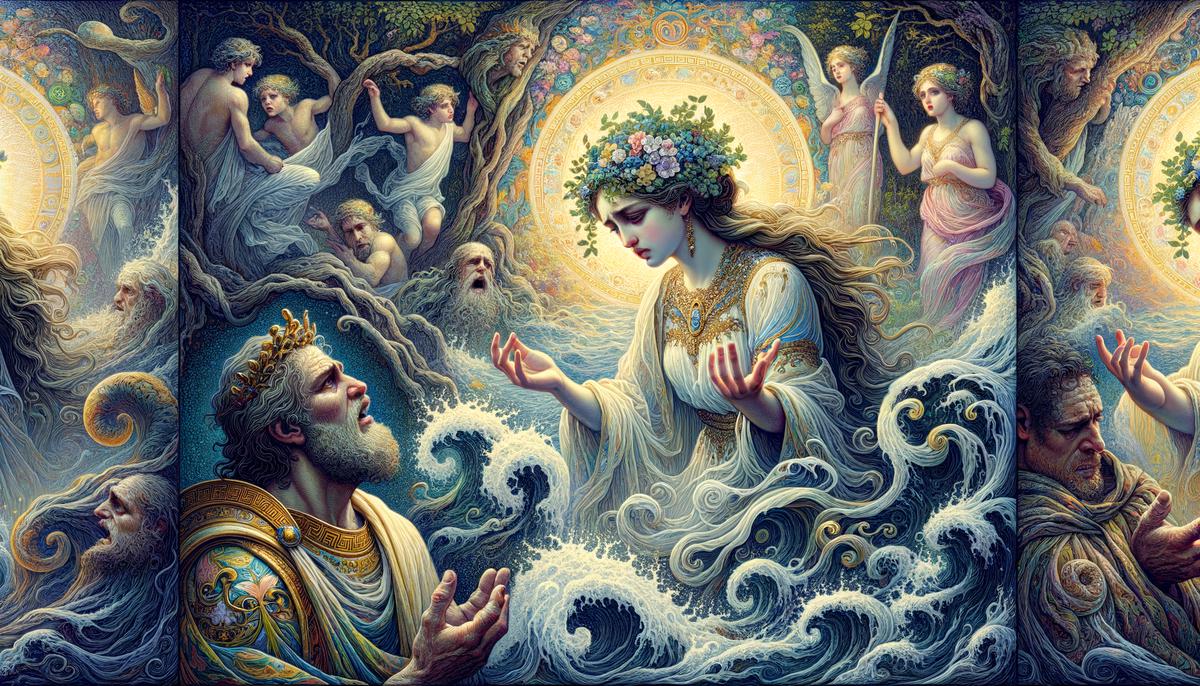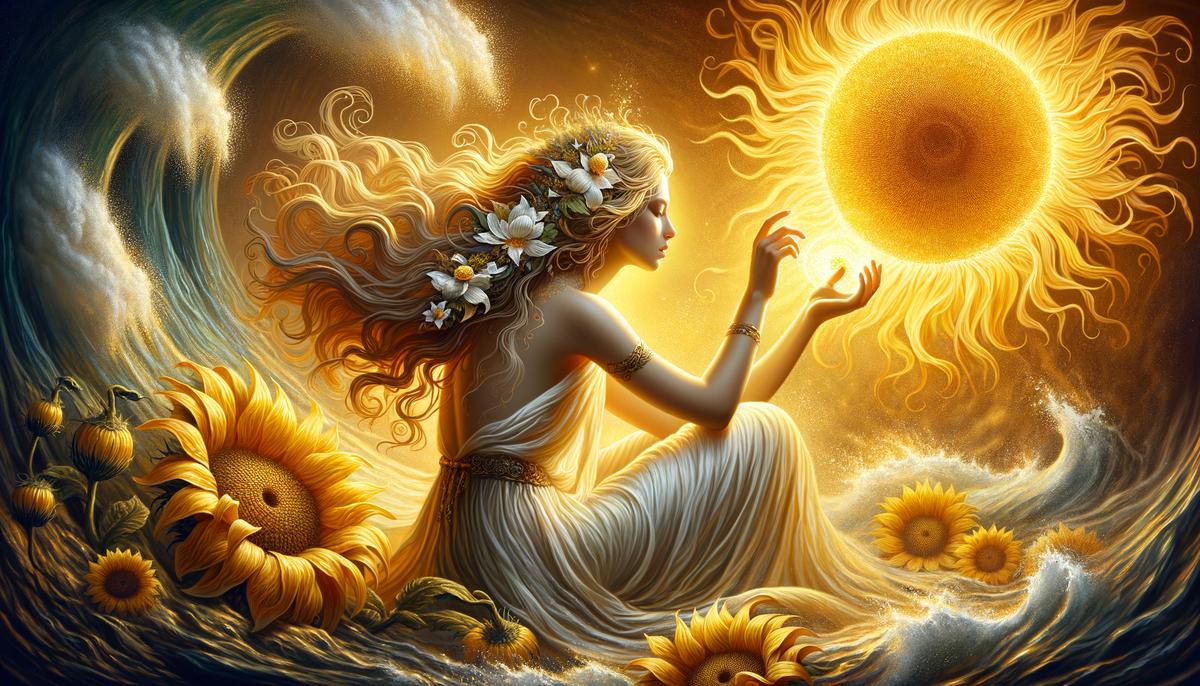Clytie's Origin and Family
In Greek mythology, Clytie was an Oceanid—a water nymph born to the Titans Oceanus and Tethys. Oceanus ruled the oceans, while Tethys reigned over the fresh waters. As one of their countless daughters, Clytie embodied the essence of aquatic realms.
Each Oceanid represented various facets of water, and Clytie was no exception. Her connection to this fundamental aspect of nature added depth to her tragic tale with Helios, evoking the cycles of life and the yearning for the sun's warmth.
Clytie's relationships with her siblings, the river gods known as Potamoi, further highlighted the intricate web of deities and demigods in Greek mythology. Despite their distinct powers and domains, they were all intertwined in narratives of love, betrayal, and destiny.
As a nymph born from such powerful lineage, Clytie's story not only symbolized the raw embodiment of the natural world but also reflected the paradoxes and conflicts common among mythological figures. Her fierce love and painful betrayal were not uncommon within her oceanic family dynamics.
Clytie's parentage added rich dimensions to her tale, aligning celestial cycles with earthly desires that resonated beyond her personal story. Every facet of her being was imbued with the currents of immortal forces, shaping both the landscape and her own fate—a testament to her compelling familial heritage.

Clytie and Helios' Love Story
Clytie's love for Helios, the sun god, began as a radiant tale filled with hope. As an oceanic nymph, her passion for the god who painted the sky with golden hues each dawn was irresistible. Helios, in turn, admired Clytie's beauty and basked in her adoration.
However, as often happens in mythology, their love was not destined to last. Helios's affections shifted towards Leucothoe, a mortal princess, spurred on by Aphrodite's mischievous machinations. Clytie, heartbroken and desperate, devised a plan to win back Helios's love.
She revealed the affair to Leucothoe's father, Orchamus, hoping that his intervention would lead Helios back to her. Tragically, Orchamus's response was to bury Leucothoe alive, a punishment rooted in ancient justice and paternal rage. This only intensified Helios's resentment towards Clytie.
Undeterred by rejection, Clytie's love transformed into an all-consuming obsession. She stripped herself of worldly ties and rooted herself to a rock, never once tearing her gaze away from Helios's chariot as it traversed the heavens. She yearned for just one glance, one flicker of reciprocation.
But Helios never looked her way again. After nine days, Clytie metamorphosed into a heliotrope flower, forever turning towards the sun, following its path obsessively yet never able to reach it. Her story became a testament to the perils of unchecked emotions and the sorrow of unrequited love.
Clytie's tale resonates across time and space, reminding us that love, like the sun, is essential yet often unattainable. It serves as a poignant lesson about the consequences of letting desire consume us and the pain of reaching for a light that will never shine upon us again.

Transformation into a Sunflower
Clytie's metamorphosis into a sunflower is more than just a tragic love story; it is a poignant allegory intertwined with the laws of nature. As she transitions from a water nymph to a creature rooted in the earth, forever facing the sun, her transformation carries profound symbolic meaning.
In the language of flowers, the sunflower stands tall, its golden face following the sun's path from dawn to dusk. This heliotropic behavior serves as a living metaphor for Clytie's enduring love and her relentless pursuit of Helios's affection. Her story becomes intertwined with the very essence of nature's cycles.
Clytie's transformation also represents the concept of rebirth and immortality in Greek mythology. By becoming a sunflower, she is not only bound to Helios's chariot but also becomes part of the mythological cosmos, forever seeking the light that once captured her heart.
Moreover, her story presents a fascinating connection to the processes of photosynthesis and heliotropism, blending a tragic love narrative with the biological sciences. Just as the sunflower relies on the sun's energy for life-sustaining photosynthesis, Clytie, in her new form, continues to depend on Helios for sustenance and warmth.
On a human level, Clytie's transformation speaks to our inherent need to follow our passions and desires, regardless of the consequences. This unwavering attachment to our loved ones or aspirations can be both nourishing and destructive, much like the sun's power to sustain life or scorch the earth.
The mythical, natural, and human elements of Clytie's story are connected by the theme of unquenchable desire and the unyielding pursuit of one's path, no matter how painful or relentless. Her tale encourages us to reflect on our own passions and the lengths we are willing to go to achieve them.

Clytie's Impact and Legacy
Clytie's heartbreaking story has captured the imagination of artists and writers throughout history, weaving her tragic love into various cultural tapestries that demonstrate her enduring appeal. From the contemplative silence of marble sculptures to the fluidity of literary works, her saga has been immortalized, influencing both classical and contemporary interpretations.
Sculptors have been particularly drawn to the transformation of Clytie into a sunflower, as seen in the works of Hiram Powers and Charles Towneley. Powers' "Bust of Clytie" exudes a tenderness and sorrow that invites empathy from the viewer. Clytie is not merely a subject of visual art; she personifies the torment and longing that often accompany love's unyielding grip.
In literature, Ovid's "Metamorphoses" recounts Clytie's devotion and subsequent transformation, encapsulating the interplay between human emotion and divine intervention. The vivid imagery used by Ovid aligns with the miraculous and tragic elements of Greek mythology, ensuring that her tale continues to inspire literary circles and romantics alike.
Contemporary expressions of Clytie's legend persist in poetry and modern storytelling, where she symbolizes unrequited love and the relentless pursuit of an elusive affection. Poets draw parallels between her sun-tracking form and the ever-present quest for acceptance and reciprocity that tugs at human hearts.
Clytie's story has also found its way into eco-poetical discourses, serving as a parable for environmental awareness. Her tale becomes a metaphor for acknowledging nature's cycles and the importance of conservation, as she chases the life-sustaining radiance of Helios.
Furthermore, Clytie's narrative has become a subject of analysis in cultural studies, where themes of feminism, martyrdom, and obsession are explored. These readings delve into her motivations, agency, and how her rebellious act against personal erosion, though driven by romantic despair, foreshadows contemporary feminist interpretations of mythic characters reclaiming their narratives.
The significance of Clytie's story in modern culture highlights the enduring relevance of ancient tales in understanding human emotions and experiences. Her persistence in love, bordering on self-destruction, strikes a chord with audiences across time, emphasizing the timeless power of mythology to illuminate the human condition.
In the end, Clytie's tale is more than just a myth; it is a testament to the depths of human longing and the relentless pursuit of the unattainable. Her transformation into a sunflower symbolizes the eternal dance between hope and despair, a motif that continues to inspire and resonate with us, reminding us of the powerful hold that love and loss have over our lives.
- Ovid. Metamorphoses. Translated by A.D. Melville, Oxford University Press, 1986.
- Morford, Mark P. O., and Robert J. Lenardon. Classical Mythology. 10th ed., Oxford University Press, 2014.
- Impelluso, Lucia. Nature and Its Symbols. J. Paul Getty Museum, 2004.
- Zajko, Vanda, and Helena Hoyle, editors. A Handbook to the Reception of Classical Mythology. Wiley Blackwell, 2017.
- Greenblatt, Jordana. "Clytie: The Story Behind the Sculpture." The Metropolitan Museum of Art Bulletin, vol. 62, no. 2, 2004, pp. 18-23.

Leave a Reply